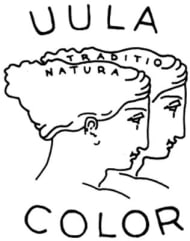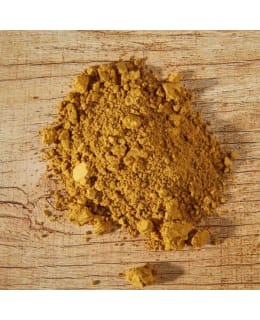Uula Keltaokra 1kg värijauhe
Price
Price of the product when purchased separately:
21,90 €
Color:
Celtaocra
Shipping costs starting from
3,90€
Yellow okra is a natural material that is made from yellow clay. The variation in iron content affects the color of Yellow Okra. Yellow okra has good light and weather resistance and is well suited for the production of oil paints. It is suitable for use in all painting techniques and for mixing with oil, lime and glue paints. Yellow ocher is also used for coloring plaster, cement, mortar, paper, cardboard and fibers. The final result of the color depends on the amount of pigment used and the binder used for it.
Ground color pigments
The earth colors found in pigments, such as ochre, terra and umber, are natural pigments that are very suitable for use in oil paints due to their light fastness and color strength. Umbras are iron oxides that are rich in manganese. The pigment is durable and has excellent light resistance. They can be combined with other pigments and are suitable for use with all binders. Iron oxide pigments are suitable for tinting concrete and mortar due to their good coloring. Ground color production is environmentally friendly. With genuine ground color pigments, beautiful and soft color shades can be created.
SUITABILITY OF YELLOW OKRA
Lightfastness: Good
Water-based binders: Good
Oil-based binders: Good
Lime or cement: Good
THE USE OF PIGMENTS FOR COLORING THE PAINT
When tinting water-based paints, the pigment should first be mixed with a small amount of water, resulting in a so-called toning paste.
The pigment is mixed with water so that the paste becomes smooth and quite thick. The finished paste is added to the paint until it is the desired shade.
The proportion of pigment should not be more than 10% in the finished paint, because too much addition of pigment weakens the paint's ability to stick to its substrate and the paint may stain even when dry.
So you cannot get very dark shades from white paint. The binder content of different paints varies, so the tinting is always specific to the paint.
In tinting oil paints, the principle is the same as in tinting water-based paints, but the pigment is first mixed with either turpentine or boiled linseed oil (in varnish).
OIL PAINT MADE FROM PIGMENTS FOR INTERIOR USE
YELLOW PAINT (approx. 1 liter)
5 dl boiled linseed oil
1 dl general thinner
700 g yellow okra
0.5 dl of serotonin
The ingredients are measured in e.g. a three-liter container and mixed vigorously with a paint mixer attached to the drill for approx. 15 – 60 min, depending on the roughness of the pigments. Finally, the paint can be filtered, so that the insoluble lumps of pigment are left out. If the paint feels too thin, you can thicken it by adding chalk flour as needed. Different pigments react differently; some need more oil to dissolve than others. In general, heavy pigments dissolve in a smaller amount of oil than light dusting pigments.
When making small batches, the pigments dissolve in a smaller amount of oil than light dusting pigments. In manufacturing, rubbing the paint pigment is important. The pigments can be finely rubbed with the oil with a pigment grinder or a palette knife on top of the glass. At first, the paint rustles against the substrate. The paint is ready when the mixture is smooth. Rub only a little paint at a time. Add more oil to the paste and the paint is ready. The paint is applied in thin layers 2-5 times. The surface is allowed to dry between layers for 2-5 days. Self-made oil paint is suitable for restoring furniture and making oil glaze. By changing the amount of pigments, the coverage of the paint can be affected.
Ground color pigments
The earth colors found in pigments, such as ochre, terra and umber, are natural pigments that are very suitable for use in oil paints due to their light fastness and color strength. Umbras are iron oxides that are rich in manganese. The pigment is durable and has excellent light resistance. They can be combined with other pigments and are suitable for use with all binders. Iron oxide pigments are suitable for tinting concrete and mortar due to their good coloring. Ground color production is environmentally friendly. With genuine ground color pigments, beautiful and soft color shades can be created.
SUITABILITY OF YELLOW OKRA
Lightfastness: Good
Water-based binders: Good
Oil-based binders: Good
Lime or cement: Good
THE USE OF PIGMENTS FOR COLORING THE PAINT
When tinting water-based paints, the pigment should first be mixed with a small amount of water, resulting in a so-called toning paste.
The pigment is mixed with water so that the paste becomes smooth and quite thick. The finished paste is added to the paint until it is the desired shade.
The proportion of pigment should not be more than 10% in the finished paint, because too much addition of pigment weakens the paint's ability to stick to its substrate and the paint may stain even when dry.
So you cannot get very dark shades from white paint. The binder content of different paints varies, so the tinting is always specific to the paint.
In tinting oil paints, the principle is the same as in tinting water-based paints, but the pigment is first mixed with either turpentine or boiled linseed oil (in varnish).
OIL PAINT MADE FROM PIGMENTS FOR INTERIOR USE
YELLOW PAINT (approx. 1 liter)
5 dl boiled linseed oil
1 dl general thinner
700 g yellow okra
0.5 dl of serotonin
The ingredients are measured in e.g. a three-liter container and mixed vigorously with a paint mixer attached to the drill for approx. 15 – 60 min, depending on the roughness of the pigments. Finally, the paint can be filtered, so that the insoluble lumps of pigment are left out. If the paint feels too thin, you can thicken it by adding chalk flour as needed. Different pigments react differently; some need more oil to dissolve than others. In general, heavy pigments dissolve in a smaller amount of oil than light dusting pigments.
When making small batches, the pigments dissolve in a smaller amount of oil than light dusting pigments. In manufacturing, rubbing the paint pigment is important. The pigments can be finely rubbed with the oil with a pigment grinder or a palette knife on top of the glass. At first, the paint rustles against the substrate. The paint is ready when the mixture is smooth. Rub only a little paint at a time. Add more oil to the paste and the paint is ready. The paint is applied in thin layers 2-5 times. The surface is allowed to dry between layers for 2-5 days. Self-made oil paint is suitable for restoring furniture and making oil glaze. By changing the amount of pigments, the coverage of the paint can be affected.
- EAN: 3700403402216
- SKU: 100948091
- Vendor material number: 200



